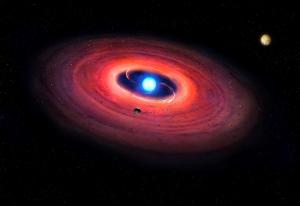Blog
Rust Belt
19 October 2019
 Mark Garlick
Mark GarlickIn the search for Earth-like worlds among the stars, much of the focus has been on finding planets in the habitable zone of a star, where they are the right distance for liquid water to exist on the surface. But that’s only one necessary ingredient for a truly Earth-like planet. Other factors such as size come into play, for example. But more subtle aspects are important as well, such as a planet’s geological composition.
To be truly Earth-like, a planet should have a similar ratio of elements such as iron, oxygen, and carbon. This ratio affects everything from the formation of rocks and minerals to the internal composition of the planet. But studying the geology of exoplanets is beyond the ability of current telescopes. We are only just beginning to study things such as their atmospheres.
But new research1 has used an ingenious method to study the composition of exoplanets indirectly. Rather than trying to study exoplanets, the work looks at white dwarf stars.
A white dwarf is the remnant of a Sun-like star that has collapsed under its gravitational weight. The gravity of a white dwarf is so strong that the heavy elements of the star sink to its core. But white dwarfs also have thin atmospheres that can contain traces of heavier elements. These elements can’t have been in the star as it collapsed into a white dwarf, so they must come from planets and other rocky bodies that have fallen into the white dwarf.
By studying the atmospheres of white dwarfs, one can learn the ratio of elements that existed in planets that once orbited the star. Recently a team did just this and looked at the ratios of the six most common elements in rocky bodies: iron, oxygen, silicon, magnesium, calcium, and aluminum. Using these ratios, they created mathematical models to determine the type of geology the planets would have had.
One of the things the team discovered is that these worlds would have had high ratios of iron and oxygen, similar to the composition of planets like Earth and Mars. This means that the exoplanets likely had a similar composition, and therefore similar geology.
In other words, as we find Earth-sized worlds orbiting Sun-like stars, the odds are good that they will also have similar geology. And that means the chances of a truly Earth-like world is higher than we once thought.
Alexandra E. Doyle, et al. “Oxygen fugacities of extrasolar rocks: Evidence for an Earth-like geochemistry of exoplanets” Science 18 Oct 2019 : 356-359 ↩︎